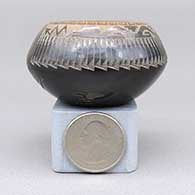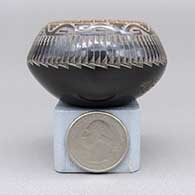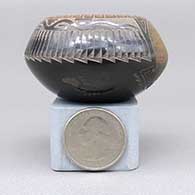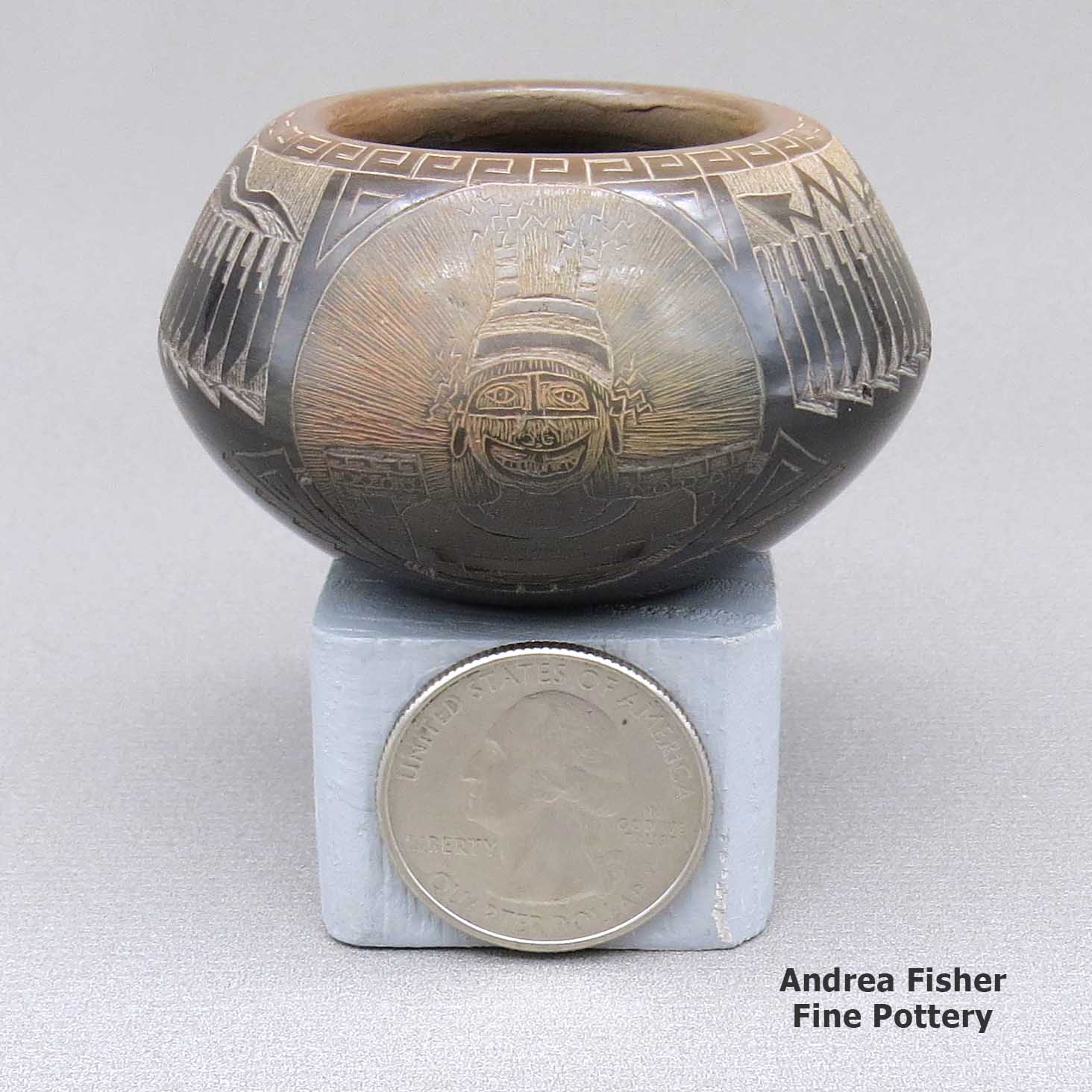
Click or tap to see a larger version
Kevin Naranjo, Santa Clara, Miniature black bowl with a sienna rim and a sgraffito koshare, pueblo, avanyu, feather ring, bear paw, and geometric design
Santa Clara
$ 375
cjsc3c260
Miniature black bowl with a sienna rim and a sgraffito koshare, pueblo, avanyu, feather ring, bear paw, and geometric design
2 in L by 2 in W by 1.25 in H
Condition: Very good
Signature: Kevin Naranjo Santa Clara Pueblo
Tell me more! Buy this piece!
(505) 986-1234 - www.andreafisherpottery.com - All Rights Reserved
Kevin Naranjo
Santa Clara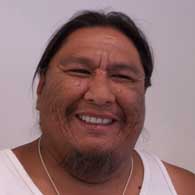
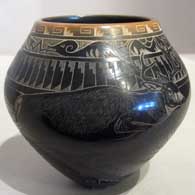
Born in 1972 at Santa Clara Pueblo, Kevin Naranjo was given a Tewa name meaning Turquoise Mountain. He says he was inspired to learn the ancient tradition of hand coiling pottery by the time he was four, that inspiration coming from his family and his love of nature.
Kevin was born into a family of famous potters, including Luther Gutierrez (his great-grandfather), Dolores Curran (a maternal aunt) and Geri Naranjo (his mother). Geri is renowned for her miniature sgraffito (fine line incised) pottery, the traditional methods of which she taught to both Kevin and his sister, Monica Naranjo Romero.
Specializing in hand coiled black/sienna sgraffito pottery, Kevin gathers his clay from sacred grounds within Santa Clara Pueblo. He digs and prepares the clay, hand-coils and shapes his forms, then lets them dry for a few days. Then he stone polishes the surfaces and ground fires his pottery using an oxygen-reduction process to make the black canvas for his designs. After firing, he etches the pot to create wonderful scenes of wildlife that live in the area of his home on Santa Clara.
The first piece he made as a child was a dinosaur. He remembers it well: it sparked an interest in molding animal figurines. That first inspiration and practice evolved until now his pottery embodies beautiful symmetry, graceful lines and finely executed sgraffito designs like as the avanyu (water serpent), kiva steps and the feather pattern. Additional figures such as bears, eagles, bighorn sheep, deer and elk are incorporated into backgrounds of pueblo ruins and mountain views.
Since 2001, Kevin has been collaborating with Tricia Pena from San Ildefonso Pueblo. Her grandfather, the late Encarnacion Pena, was a member of the original San Ildefonso School of Painters. Together Kevin and Tricia are passing the art of pottery making on to their children.
Kevin has consistently earned awards for his sgraffito and miniature pottery since starting to compete in 1994. Most recently, he received Best of Division for miniature sgraffito at the 2006 Santa Fe Indian Market.
Santa Clara Pueblo

Ruins at Puye Cliffs, Santa Clara Pueblo
Santa Clara Pueblo straddles the Rio Grande about 25 miles north of Santa Fe. Of all the pueblos, Santa Clara has the largest number of potters.
The ancestral roots of the Santa Clara people have been traced to ancient pueblos in the Mesa Verde region in southwestern Colorado. When that area began to get dry between about 1100 and 1300 CE, some of the people migrated eastward, then south into the Chama River Valley where they constructed several pueblos over the years. One was Poshuouinge, built about 3 miles south of what is now Abiquiu on the edge of the Jemez foothills above the Chama River. Eventually reaching two and three stories high, and with up to 700 rooms on the ground floor, Poshuouinge was occupied from about 1375 CE to about 1475. Drought then again forced the people to move, some of them going to the area of Puye (on the eastern slopes of the Pajarito Plateau of the Jemez Mountains) and others downstream to Ohkay Owingeh (San Juan Pueblo, along the Rio Grande). Beginning around 1580 CE, drought forced the residents of the Puye area to relocate closer to the Rio Grande and they founded what we now know as Santa Clara Pueblo on the west bank of the river, with San Juan Pueblo to the north and San Ildefonso Pueblo to the south.
In 1598 the seat of Spanish government was established at Yunque, near San Juan Pueblo. The Spanish proceeded to antagonize the Puebloans so badly that that government was moved to Santa Fe in 1610, for their own safety.
Spanish colonists brought the first missionaries to Santa Clara in 1598. Among the many things they forced on the people, those missionaries forced the construction of the first mission church around 1622. However, like the other pueblos, the Santa Clarans chafed under the weight of Spanish rule. As a result, they were in the forefront of the Pueblo Revolt of 1680. One Santa Clara resident, a mixed black and Tewa man named Domingo Naranjo, was one of the rebellion's ringleaders. However, the pueblo unity that allowed them to chase the Spanish out fell apart shortly after their success, especially after Popé died.
When Don Diego de Vargas came back to the area in 1694, he found most of the Santa Clarans on top of nearby Black Mesa (with the people of San Ildefonso). A six-month siege didn't subdue them so finally, the two sides negotiated a treaty and the people returned to their pueblos. However, successive invasions and occupations by northern Europeans took their toll on all the tribes over the next 250 years. Then the swine flu pandemic in 1918 almost wiped them out.
Today, Santa Clara Pueblo is home to as many as 2,600 people and they comprise probably the largest per capita number of artists of any North American tribe (estimates of the number of potters run as high as 1-in-4 residents).
Today's pottery from Santa Clara is typically either black or red. It is usually highly polished and designs might be deeply carved or etched ("sgraffito") into the pot's surface. The water serpent, (avanyu), is a very common traditional design motif on Santa Clara pottery. Another motif comes from the legend that a bear helped the people find water during a drought. The bear paw has appeared on much of their pottery ever since.
Santa Clara has received a lot of distinction because of the evolving artistry the potters have brought to their craft. Not only did this pueblo produce excellent black and redware, several notable innovations helped move pottery from the realm of utilitarian vessels into the domain of art. Different styles of polychrome redware emerged in the 1920s-1930s. In the early 1960s experiments with stone inlay, incising and double firing began. Modern potters have also extended the tradition with unusual shapes, slips and designs, illustrating what one Santa Clara potter said: "At Santa Clara, being non-traditional is the tradition." (This refers strictly to artistic expression; the method of creating pottery remains traditional).
Santa Clara Pueblo is home to a number of famous pottery families: Tafoya, Baca, Gutierrez, Naranjo, Suazo, Chavarria, Garcia, Vigil, and Tapia - to name a few.



Santa Clara Pueblo at Wikipedia
Pueblos of the Rio Grande, Daniel Gibson, ISBN-13:978-1-887896-26-9, Rio Nuevo Publishers, 2001
Upper photo courtesy of Einar Kvaran, Creative Commons Attribution-Share Alike 3.0 Unported License
Koshares
Most Pueblos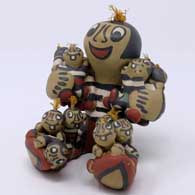
Margaret and Luther Gutierrez
Santa Clara
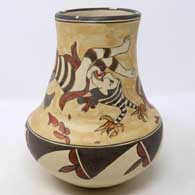
Lois Gutierrez
Santa Clara
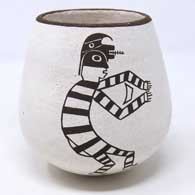
Emma Lewis
Acoma
Among the religious figures in Pueblo societies is an order of "sacred clowns," also known as Chiffoneti. Among the Hopi they are a group of five distinct figures known collectively as Payakyamu. They are also known as Kossa in the Tewa language, Koshare in the Keres language, Tabosh among the Jemez and Newekwe among the Zunis. The terms are a bit generic as each pueblo has its own unique names and those names will vary according to the kiva (confraternity or secret society) they belong to. Each has a unique role in the community year-round (to invoke rainfall in particular) and perform in the annual spring and summer fertility rites.
Among the Hopi there are 5 clown figures: 4 of which are katsinam (personifications of spirit). The fifth is the Koshare, a figure that came to Hopi country with the Tewas who migrated there in the years after the 1680 Pueblo Revolt. When a Hopi dancer dons the mask of a katsina it is believed that the dancer's personality abandons the body and that spirit possesses it.
Among the other Pueblo peoples, the sacred clowns don't wear masks. Instead, they present themselves with black and white horizontal stripes painted on their faces and bodies, paint black circles around their eyes and mouthes, and part their hair down the middle and bind it in two bunches which stand upright on either side of their head and trim those bunches with corn husks.
Their function is to help defuse community tensions by offering their own humorous take on their tribe's popular culture, by communicating tribal traditions and by reinforcing tribal taboos.
European courts often used to have a "jester" who offered similarly meaningful and humorous social commentary on activities in the court and the kingdom. Juan Suni was a Hopi Koshare who performed his duties one day in 1656 by impersonating the resident Franciscan priest at Awatovi. He continued living life as a Koshare as he journeyed from Hopi country to Santa Fe, where he was arrested and put on trial in 1659. The Spaniards recounted a number of "offenses" Juan performed on his journey and they sentenced him to 20 years of slavery for his actions. 40 years later, the Hopis destroyed Awatovi, burning the pueblo, tearing down the walls and killing all the residents: Awatovi at the time was the largest pueblo in Hopi country (although most residents seem to have spoken Towa) and was also the site of the only Spanish mission in all of Hopiland.
Miniatures
Most people think that miniature pottery is something new in the world of Native American pottery. In reality, archaeologists have found miniature pottery in the remains of ancient ruins in Chaco Canyon, Mesa Verde, across eastern Arizona, southern New Mexico and south to the Paquimé and Casas Grandes region in northern Mexico. Archaeologists working in the eastern US have found miniature pottery spread across Early Woodland Culture sites, too, dated up to 1700 years ago.
We have no idea as to why the ancients created miniature pottery but there's lots of speculation. Perhaps it was made as toys for children. Perhaps it was made by children learning to make pottery, and as their expertise grew, the size of their pieces grew, too. Perhaps it was made and placed in a firing pit as a good luck charm, hoping that other pots being fired in the pit would survive the firing process and not crack or break. Perhaps it was made for some ceremonial purpose we have no possibility of knowing. We do know that in North America, almost every pottery-making group of ancients made miniature pottery. They decorated it, too, just like the full size pottery the women of the time were making.
As the rebirth of traditionally made Native American pottery has unfolded over the last century, research into the ancient forms, styles and designs has also brought the miniature back into focus. There are more than a few potters these days making tiny gems again, similar to and, at the same time, more refined than the products of the potters of prehistory. And while some are still being made by children learning as they grow up, many more are being made by established adult potters. Some have made their entire careers around the making of miniatures while others sometimes make a few miniatures to complement the full range of forms and styles of full size pieces they make.
Ursulita Naranjo Family Tree
Disclaimer: This "family tree" is a best effort on our part to determine who the potters are in this family and arrange them in a generational order. The general information available is questionable so we have tried to show each of these diagrams to living members of each family to get their input and approval, too. This diagram is subject to change should we get better info.
- Ursulita Naranjo (1924-1988) and Alfred Naranjo
- Dolores Curran & Alvin Curran (San Juan)(1953-1999)
- Ursula Curran
- Geri Naranjo
- Kevin Naranjo (1972-)
- Monica Naranjo
- Alfred Ervin Naranjo & Jennifer Sisneros
- Alfred Naranjo (1980-)
Some of the above info is drawn from Pueblo Indian Pottery, 750 Artist Biographies, by Gregory Schaaf, © 2000, Center for Indigenous Arts & Studies
Other info is derived from personal contacts with family members and through interminable searches of the Internet.
Copyright © 1998-2025 by

